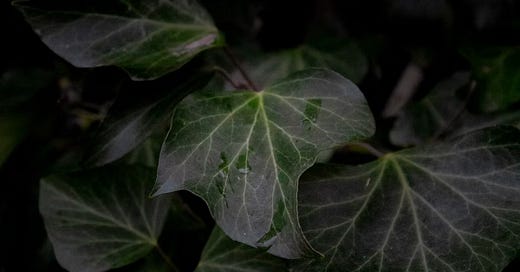“The force that through the green fuse drives the flower…”
— Dylan Thomas
Green is not just background. It creeps in, roots down, coils itself around desire, fear, memory. Dylan Thomas understood this: green as force, as fuse, as something lit and driving through the stem, the blood, the page. Green isn’t static. It spreads.
In The Great Gatsby, green is longing. It is that sharp, glinting light at the end of Daisy’s dock: a colour the eye can’t quite fix on, a future that keeps receding. Gatsby stretches toward it. He wants what it promises: renewal, possession, the past remade. But the green light moves away. It’s a fiction. That’s what makes it so irresistible. Fitzgerald gives us green as illusion, as yearning so bright it blinds. The lawns are manicured, the shirts are pastel, but under all that shine is rot.
Earlier, and stranger, is the green of Sir Gawain and the Green Knight. This is not soft or symbolic. The Green Knight is vivid, laughing, inhuman. He carries his own severed head and bleeds nothing. Green is his skin, his hair, his world. It’s life pushed so far it becomes something else. Something uncanny. When Gawain flinches beneath the axe, it’s not just death he fears, but exposure. The green figure tests not just his courage, but his limits. This is not the green of gardens or light. This is wildness and judgment, gleaming in the cold. In each of these works, green is never passive. It acts: on characters, on space, on narrative.
In The Secret Garden, green is what returns. At first, the landscape is bare: grey stone, shut doors, brambles. Mary is brittle, silent, and closed. But the garden remembers. When she finds it, overgrown and sealed off, it begins to green again. Shoots push up. Ivy reclaims the walls. The book is full of small returns: colour, appetite, warmth, language. Green here is patience, and then transformation. It doesn’t rush. It waits. And when it comes, it brings everything with it: health, grief, tenderness, a kind of forgiveness. Burnett’s green is maternal without sentimentality; it grows around you while you’re not looking.
In Rebecca, green is no longer gentle. The grounds of Manderley are thick with it: ivy, rhododendrons, waxy leaves, oppressive hedges. The garden isn’t a place of growth; it’s a kind of haunting. The green here suffocates. It climbs the windows and blots out the light. It’s not life, but concealment. Rebecca herself becomes part of it; it is half memory, half myth, rooted in the house even in death. What should be lovely is too much. Even beauty chokes. The narrator is unnamed, overlooked, lost in the green of someone else’s story.
In H is for Hawk, Helen Macdonald turns to the green world in grief. After her father dies, she begins training a goshawk: a wild, merciless creature. The countryside she moves through is not picturesque but elemental: wet leaves, mist, thorns, frostbitten mornings. Green here is the texture of mourning, both comforting and indifferent. There are passages where the earth steadies her. Others where it refuses to respond. The hawk doesn’t care about her loss. The land doesn’t answer back. But being in it, among trees, water, undergrowth, makes something possible. Not healing, exactly. But a kind of return to sensation. To being in the world, even when the world doesn’t console.
Green in literature rarely behaves. It pulls in opposite directions: toward life and decay, desire and danger, softness and edge. It is childhood and wilderness, envy and resurrection. It is what grows, and what won’t stop growing. A garden, a ghost, a future. Something half-seen, half-felt, pressing up through the story. We read green not just on the page, but in ourselves: in every place we’ve grown or withered or wanted too much.
The force that drives the flower drives the plot. Green always finds a way in.





Neruda wrote in green ink , he said it was the color of hope. thank you for this one.
This is wonderful, and a reminder that green meets me here each and every day. 💕 Loved this. x